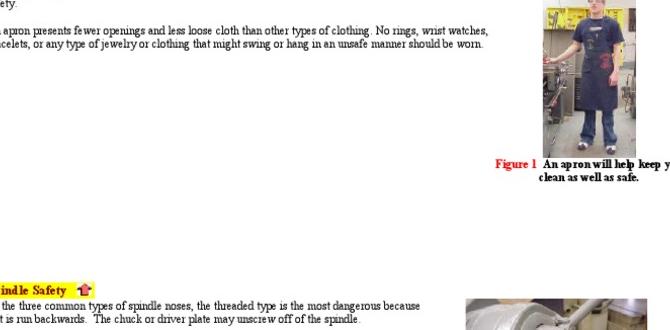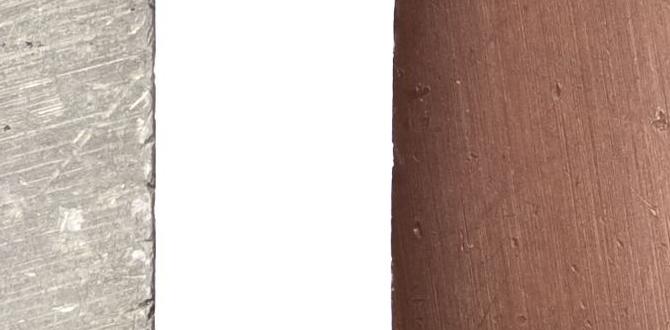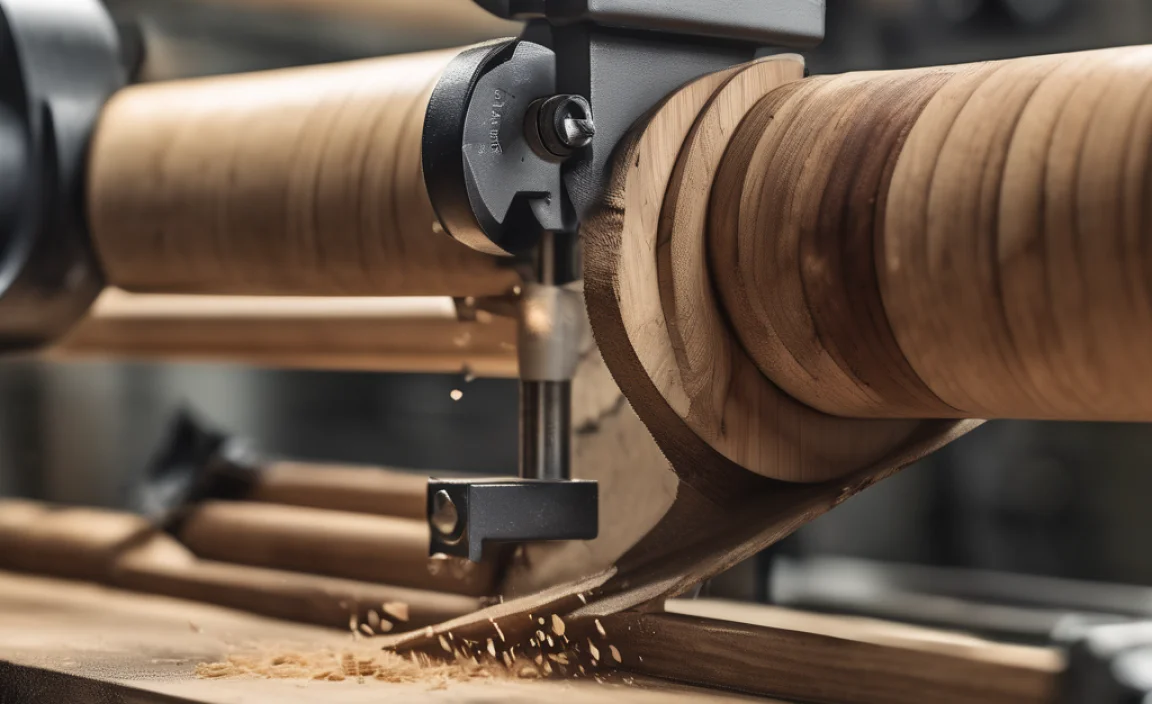Quick Summary: Dealing with chatter and deflection when milling 7075 aluminum? A high-quality carbide end mill designed for aluminum, with the right flute count, helix angle, and cutting parameters, is your secret weapon. Learn how to choose and use it for clean, chatter-free cuts with Lathe Hub.
Milling 7075 aluminum can be a bit tricky. You’ve got this fantastic, strong material that’s perfect for projects, but it also has a tendency to fight back. When your end mill chatters or deflects, it leaves rough surfaces and can even damage your workpiece or tool. It’s frustrating, right? You’re aiming for smooth, precise cuts, but you end up with vibration marks and poor tolerances. The good news is, with the right approach and the right tool, you can conquer this challenge. We’re going to walk through exactly how to pick the perfect carbide end mill and use it to make those stubborn 7075 aluminum parts shine.
Why 7075 Aluminum is a Special Case (And How to Handle It)
7075 aluminum is like the superhero of aluminum alloys. It’s incredibly strong, often rivaling some steels, thanks to its zinc-based alloying element. This makes it a top choice for structural components in aerospace, automotive, and high-performance sporting goods. However, this strength and hardness also mean it can be more prone to issues like deflection and chatter when you’re machining it, especially with standard tooling.
When an end mill deflects, it bends away from the cutting force. This can happen if the tool isn’t stiff enough, if the cutting parameters are too aggressive, or if the material itself is unusually tough. Chatter is the audible (and often visible!) result of this deflection and spring-back, leading to those nasty vibration marks on your part. For 7075, which is harder than many other aluminum alloys, these issues are amplified. Getting a clean finish often requires a delicate balance of tool geometry, material properties, and cutting strategy. Fortunately, understanding a few key principles can make all the difference.
What Exactly IS Deflection and Chatter?
Let’s break down these common machining headaches in simple terms:
- Deflection: Imagine pushing on a ruler. If you push too hard, it bends. In milling, the cutting forces from the end mill trying to remove material can cause the tool itself, or even the workpiece and machine spindle, to bend slightly. When this bending happens, the cutter isn’t following its intended path perfectly.
- Chatter: This is what happens when deflection occurs rapidly and repeatedly. As the tool deflects, it loses contact with the material or cuts inconsistently. Then, it springs back, and the cycle repeats. This creates a vibration pattern, often heard as a high-pitched squealing or a rough, bumpy sound, and seen as distinct ridges or waves on the machined surface.
For 7075 aluminum, its inherent strength means these forces can be significant. Any flex in the system, whether it’s the tool holder, the spindle bearings, or the end mill itself, can contribute to problems. We need tools and techniques that are rigid and resistant to bending.
The Star Player: The Carbide End Mill
When it comes to tackling tough materials like 7075 aluminum, carbide end mills are your best friends. Why carbide? Let’s look:
- Hardness: Carbide is significantly harder than High-Speed Steel (HSS). This means it can maintain its cutting edge longer and handle higher cutting speeds and temperatures without dulling quickly.
- Rigidity: Carbide is also a stiffer material. This inherent rigidity helps it resist bending (deflection) under cutting forces, which is crucial for 7075.
- Heat Resistance: Machining aluminum generates heat. Carbide’s ability to withstand high temperatures allows for faster machining speeds without sacrificing tool life or performance.
While HSS end mills can be used for aluminum, they are much more likely to deflect and wear out quickly when working with a demanding alloy like 7075. For consistent, high-quality results, especially for beginners, sticking with carbide is the way to go.
Choosing the Right Carbide End Mill for 7075 Aluminum
Not all carbide end mills are created equal, especially when it comes to milling specific materials. Here’s what to look for:
1. Material Coating: A Shine That Means Business
Many carbide end mills come with special coatings that dramatically improve their performance. For aluminum, some coatings are better than others:
- Uncoated: Simple and effective for general-purpose aluminum cutting, but can be prone to “chip welding” where aluminum bits stick to the cutting edge.
- ZrN (Zirconium Nitride): This gold-colored coating is excellent for aluminum. It’s harder than the base carbide and has a low coefficient of friction, which helps prevent chip welding and reduces heat buildup. This is a great starting point.
- TiB2 (Titanium Diboride): Often greenish-gray in appearance, TiB2 coatings are super hard and offer superior lubricity. They excel at preventing chip welding and can significantly extend tool life in aluminum alloys like 7075.
- Diamond Coatings (DLC): These are the premium option for aluminum. They offer the ultimate in hardness and lubricity, virtually eliminating chip welding and allowing for very high cutting speeds. However, they are also the most expensive.
For 7075, I’d highly recommend looking for a ZrN or, if your budget allows, a TiB2 or DLC coated end mill. These coatings are specifically designed to combat the sticky nature of aluminum and reduce the friction that leads to deflection.
2. Flute Count: The Teeth That Do the Work
The number of flutes (the spiral cutting edges) on an end mill directly impacts how it cuts:
- 1 or 2 Flutes: These are ideal for soft metals like aluminum. They provide excellent chip evacuation because there’s more open space between the flutes. Good chip evacuation is critical with aluminum to prevent material from packing up and causing tool breakage or poor surface finish. They also tend to generate less heat.
- 3 Flutes: A good all-around choice. They offer a balance between chip space and tool rigidity. Often considered the best compromise for aluminum.
- 4 Flutes or More: Generally best suited for harder materials like steel. They offer greater rigidity but have less chip clearance, making them prone to chip packing and overheating in aluminum.
For 7075 aluminum and minimizing deflection, 2-flute or 3-flute end mills are generally your best bet. A 2-flute offers maximum chip clearance, which is great for keeping the cut clean. A 3-flute provides a bit more rigidity while still having decent chip clearance. You’ll rarely need more than 3 flutes for aluminum.
3. Helix Angle: How the Spirals Twist
The helix angle is the steepness of the spiral flutes. It affects how the tool engages the material and how smoothly it cuts:
- Low Helix Angle (e.g., 20-30 degrees): These are often called “slow helix” or “fast spiral” end mills. They engage the material more gradually, leading to smoother cuts and less vibration. This is excellent for reducing chatter.
- High Helix Angle (e.g., 45-60 degrees): These are “fast helix” or “high spiral” end mills. They have a steeper twist, which can provide a more aggressive cutting action and better chip evacuation in some materials. However, for gummy materials like 7075, they can sometimes induce more chatter if not used carefully.
For 7075 aluminum, a variable helix or a high helix angle (around 45 degrees) is often recommended. The steeper angle can help break chips into smaller pieces, which is good for aluminum. However, sometimes a slightly lower helix might provide a smoother entry and exit into the cut, reducing chatter. It’s a bit of a trade-off, but a good general-purpose aluminum end mill will have a helix angle optimized for this. Look for end mills specifically marketed for aluminum, as they’ll often have this feature sorted.
4. End Mill Geometry: The Shape of the Cutting Edge
The profile of the cutting edge also matters:
- Square End Mills: These have a flat, 90-degree corner. They are versatile and common.
- Ball End Mills: These have a rounded tip, useful for creating contoured surfaces and fillets.
- Corner Radius End Mills: These have a small radius at the corner, offering a balance between the sharp corner of a square end mill and the full radius of a ball end mill. This radius helps to strengthen the cutting edge and can reduce stress, potentially leading to less chipping and chatter.
For 7075, corner radius end mills can be a great choice. The slight radius at the corner helps to create a stronger cutting edge and can smooth out the cutting action, which reduces the tendency for chatter compared to a sharp square corner. The radius should be appropriate for your desired feature; a common choice for general milling is a 0.030″ or 0.060″ (around 0.8mm to 1.5mm) radius for smaller end mills.
5. Shank Diameter and Extended Reach
When you’re facing deflection, tool rigidity is king. A thicker shank is inherently stiffer than a thinner one.
- Standard Shank: The most common type, typically 1/4″, 3/8″, 1/2″ (or 6mm, 8mm, 12mm in metric).
- Reduced Shank / “Pot Belly” End Mills: These have a thicker body below the cutting flutes, offering increased rigidity without increasing the tool holder size.
- Long Reach End Mills: These are designed to reach deeper into cavities. However, “long reach” often means a thinner, longer tool, which is more prone to deflection.
For 7075, use the largest possible shank diameter that fits your tool holder and machining needs. If you need to reach deep, you might need a long-reach end mill, but be prepared to potentially compromise on cutting speed or depth of cut to manage deflection. Always aim for the shortest possible overhang (the amount the end mill sticks out of the tool holder). A tool sticking out only 1-2 times its diameter is much stiffer than one sticking out 4-5 times its diameter.
Recommended End Mill Specifications for 7075 Aluminum
Based on all this, here’s a general guide to what you should look for:
| Feature | Recommendation for 7075 Al | Why it Helps |
|---|---|---|
| Material | Solid Carbide | Hardness, Rigidity, Heat Resistance |
| Flute Count | 2 or 3 Flutes | Excellent chip evacuation, good balance of rigidity |
| Coating | ZrN, TiB2, or DLC | Reduces chip welding, increases lubricity, lowers friction |
| Helix Angle | Variable or High (around 45°) | Good chip control, smooth cutting action |
| End Type | Corner Radius (slight) or Square | Strengthens cutting edge, can reduce chatter |
| Shank Diameter | Largest practical size (e.g., 1/2″ or 12mm) | Maximizes rigidity to fight deflection |
| Overall Length | As short as possible for the job | Minimizes tool overhang and potential for deflection |
A very common and effective tool might be a 3-flute, ZrN-coated, solid carbide end mill with a short corner radius (e.g., 0.030″) and a standard 1/2″ (or 12mm) shank.
Advanced Tip: Single-Flute End Mills
For particularly gummy aluminum alloys, some machinists swear by single-flute end mills. These offer even more chip clearance than two-flute designs. However, they can be less rigid and might generate more vibration if not set up perfectly. For 7075, I’d still lean towards 2 or 3 flutes for a beginner because they offer better stability. But if you’re an experienced user facing persistent chip packing issues, a single-flute might be worth exploring.
Setting Up for Success: Cutting Parameters
Even with the perfect end mill, incorrect cutting parameters will lead to deflection and chatter. Here’s a simplified guide. Remember, always start conservatively and increase gradually.
1. Spindle Speed (RPM)
This is how fast the end mill spins. Carbide tools can often run much faster than HSS.
A good starting point for carbide on 7075 aluminum is often in the range of:
- For a 1/4″ (6mm) end mill: 6,000 – 12,000 RPM
- For a 1/2″ (12mm) end mill: 4,000 – 8,000 RPM
Manufacturer recommendations are your best bet here. You can find general cutting data charts online from reputable tool manufacturers like Sandvik Coromant or Google “7075 aluminum carbide end mill speeds and feeds.”
2. Feed Rate
This is how fast the tool moves through the material. A proper feed rate is crucial for chip formation and evacuation.
A good starting point for feed rate (in inches per minute, IPM, or millimeters per minute, mm/min) often relates to the chip load per tooth. Chip load is the thickness of the material each cutting edge removes. For aluminum, a chip load might be:
- For a 1/4″ (6mm) 3-flute end mill: 0.002″ – 0.005″ (0.05mm – 0.12mm) per tooth. So, 3 flutes 0.004″ 7,000 RPM = 84 IPM (approx. 2150 mm/min).
- For a 1/2″ (12mm) 3-flute end mill: 0.004″ – 0.008″ (0.1mm – 0.2mm) per tooth. So, 3 flutes 0.006″ 5,000 RPM = 90 IPM (approx. 2300 mm/min).
Key takeaway: Don’t feed too slowly! Feeding too slowly can cause the tool to rub rather than cut, leading to heat buildup, chip welding, and chatter. You want to hear a consistent chip-making sound, not a scraping or squealing sound.
3. Depth of Cut (DOC) and Width of Cut (WOC)
These determine how much material is removed with each pass. This is where you have the most control over cutting forces.
- Depth of Cut (DOC): How deep the tool cuts into the material.
- Width of Cut (WOC): How wide the cut is.
For 7075 aluminum, especially if you’re experiencing deflection, you should:
- Take lighter depths of cut. Instead of trying to get all the material off in one pass, take multiple shallower passes. For example, if you need to remove 1/4″ (6mm) of material, try taking 3-4 passes of 1/16″ (1.5mm) or less.
- Use a light width of cut, especially in harder materials or when slotting. For full slotting (cutting a groove the full diameter of the end mill), the WOC is 100% of the tool diameter. This puts a lot of stress on the tool. Try using techniques like “adaptive clearing” or “trochoidal milling” in your CAM software. These methods use a small WOC (e.g., 20-40% of the tool diameter) and move the tool in a helical path to remove material more gradually, significantly reducing cutting forces and heat. The National Institute of Standards and Technology (NIST) has published excellent resources on machining best practices, including adaptive machining strategies, which can be found on their Manufacturing Extension Partnership (MEP) website.






